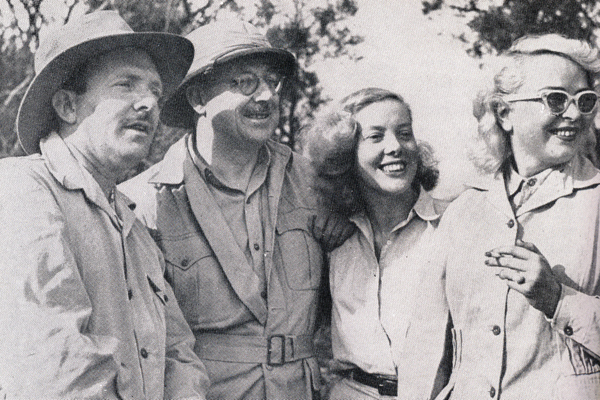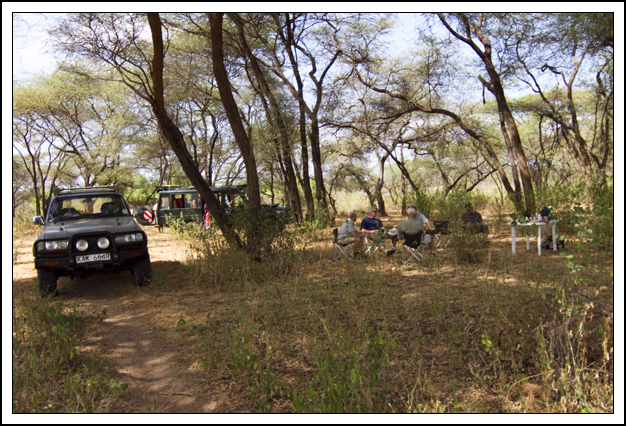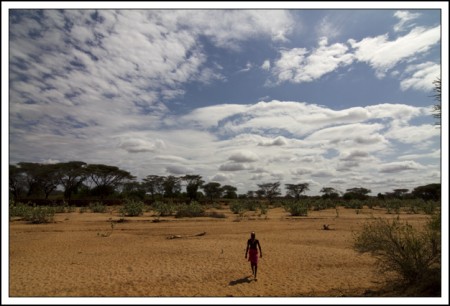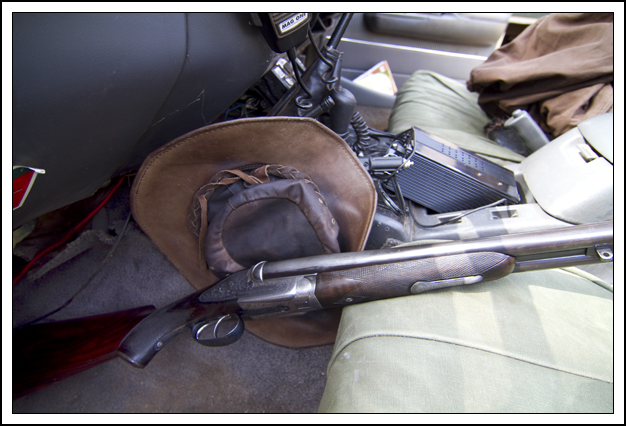
Robert Ruark, far left, and his wife, Virginia, far right, with Armand and Poochy Denis, explorer-filmmakers, in 1951.
Have you ever read Robert Ruark? God, you should. Another one of those people who, like Osa and Martin Johnson, was quite famous in his time and is now largely forgotten. He was a journalist and a columnist and magazine writer as well as an author. Around 1950, he was as well known (and almost as controversial) as someone like Rush Limbaugh is now. (The good news; if history has forgotten about Robert Ruark, who wrote 19 books and over 1,000 magazine articles in a career that lasted about 20 years, surely no one will have any idea who Rush Limbaugh is ten years after he dies).
Anyway, in 1951 Ruark spent $10,000 of his own money (even he admitted he must be crazy) to go on a two-month safari with his wife, Virginia, led by Harry Selby, then a young, unknown professional hunter for the safari company Ker & Downey. That safari, chronicled in the book he wrote about it, Horn of the Hunter, turned out to be a life-altering event for him, Virginia, and for Harry Selby. They all became famous.
That was fine for Harry Selby (after the book came out, clients had to book him five years in advance) but not so great for Robert and Virginia. Robert Ruark, who always like his gin, became a raging alcoholic (as did Osa Johnson following the success of her book, I Married Adventure; I guess being a successful writer doesn’t necessarily make you happy. Too bad about that) and a few years later, he and Virginia divorced.
Ruark suffered liver failure and died in a London hospital in 1965. He was only 49 years old. Virginia, who had her own drinking problems, died six months later (a biography of the Ruarks says that while Robert was “a cheerful drinker of unbelievable capacity, Virginia tended to become drunk quickly. Even when not drinking, she had periods in which she wandered vaguely, as if her mind was elsewhere. Ruark referred to these periods as her “fits,” compared them to his own “cutouts,” and bluntly ascribed them to alcohol. Virginia looked for other explanations, but it was obvious alcohol was at the root of her psychological problems, even if you concede his infidelity was the cause of her drinking.”)
Anyway, this afternoon I was sitting around camp, lazing on one of the large sofas in the mess tent while everyone else took a nap, rereading Ruark’s Horn of Hunter. It was warm and still and dusty out and I thought I might sneak in a G&T while everyone else was dozing, so I called over Jarso who was trying to make himself look busy by slowly wiping a wet cloth over the same stretch of bar he’d cleaned five minutes ago and five minutes before that.
I asked him if I might be able to get a gin and tonic and then went back to my reading:
“We drank quite a lot, for outdoor types,” Ruark writes. “We’d roll back to camp about 1 P.M. after a hard morning’s hunt, starved, thirsty, and dust-covered. The ginny bottle would be hanging, coolly beaded with sweat from the evaporation of the water bag. I was bartender, it always seemed.
“’What’ll it be? Dr. Ruark’s nutritious, delicious, character-molding martini, or one of those gin-and-nonsense things that children drink?” Gin-and-nonsense was Gordon’s elixir of life mixed with Rose’s lime juice or tonic. Harry and Virginia usually drank gin-and-nonsense. I am a martini man myself. Over six weeks we used up forty-six bottles of gin and a little less than half a bottle of vermouth. I like martinis dry.
“We drank, sitting in the comfortable camp chairs, with the mess tent cool and breezy and the river trees green and soothing for us to look at, and the fact that the martinis were warm in their plastic cups and that the bees dive-bombed the attractive nonsense drinks did not detract from the flavor or the effect. We drank a lot. Three apiece before lunch killed the whole bottle. But we never got tight. We never felt bad.”
Wait…did he say that three people drank off 46 bottles of gin in six weeks? “But we never got tight. We never felt bad.” Holy shit.
Right about then, Jarso came back carrying my gin and tonic on a wooden tray. He started to set it down. It looked delicious and I was sure I could smell the juniper berries and lime even before my hand touched the beading glass.
“I’m sorry to bother you again, Jarso,” I said, “but I think I’ve changed my mind about that drink. Would it be possible to get a cup of tea instead?”
“Tea, sir?”
“Yes.”
“You don’t want the gin?”
“Well, yes, I do. Awfully much. Which is why I think I won’t.”
Jarso picked up the glass and put it back on the tray without saying a word. I’m sure he thought I was quite mad but then again, I think that’s the way they feel about us mzungus in general.
And the tea was just fine. Not delicious, not wondrous, like a wicked gin-and-nonsense, but fine nonetheless.








Recent Comments